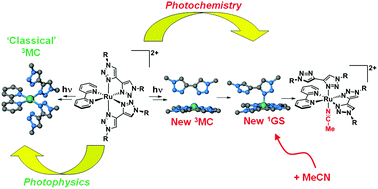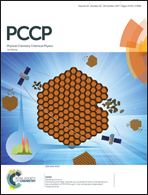Theoretical illumination of highly original photoreactive 3MC states and the mechanism of the photochemistry of Ru(ii) tris(bidentate) complexes†
Abstract
We have identified highly novel photoreactive 3MC states of ruthenium(II) 4,4′-bi-1,2,3-triazolyl (btz) complexes of the form [Ru(N^N)(btz)2]2+ and have elucidated the mechanism of the highly unusual experimental observations of photochemical ligand dechelation and concomitant ligand rearrangement reactivity to form unusual photoproducts trans-[Ru(N^N)(κ2-btz)(κ1-btz)(solvent)]2+. The triplet metal-to-ligand charge-transfer (3MLCT) states and classical Jahn–Teller type triplet metal-centred (3MC) states of the series of complexes [Ru(N^N)3−n(btz)n]2+ (btz = 4,4′-bi-1,2,3-triazolyl; N^N = 2,2′-bipyridyl (bpy), n = 0 (1), 1 (2), 2 (3), 3 (5); N^N = 4-(pyrid-2-yl)-1,2,3-triazole (pytz), n = 1 (4)) have been optimised by density functional theory (DFT) and characterised. There is a gradual and significant destabilisation of the 3MLCT states as the triazole content of the complexes increases, which occurs with a slight stabilisation of the 3MC states. Whilst consistent with the promotion of photochemical reactivity in the heteroleptic complexes of the series relative to 1, these classical 3MC states fail to account for the extraordinary ligand rearrangement processes that accompany ligand ejection. Thorough theoretical exploration of the lowest excited triplet potential energy surface (3PES) here reveals the existence of a new type of 3MC state and the role it plays in the photochemical reactivity of the complexes. This newly discovered state, called MC(F), displays a flattened geometry (indicated by the ‘F’ in the parentheses) which makes it clearly on the path to achieving the coplanarity of the bidentate ligands in the experimentally observed trans-photoproduct. Further novel ‘pentacoordinate’ 3MC states with coplanar bidentate ligands, called MC(P) (where the ‘P’ in the parentheses denotes the pentacoordinate character), were then identified and optimised. The energy barriers between the different triplet states were confirmed to be small which makes all triplet states accessible. Solvent trapping, which occurs on the singlet PES according to Wigner's rules, is finally achieved by a singlet pentacoordinate species to yield the monosolvento photoproduct. Thus, our calculations not only reveal highly novel 3MC states but more significantly demonstrate their crucial role in the formation of the experimentally observed photoproducts.



 Please wait while we load your content...
Please wait while we load your content...